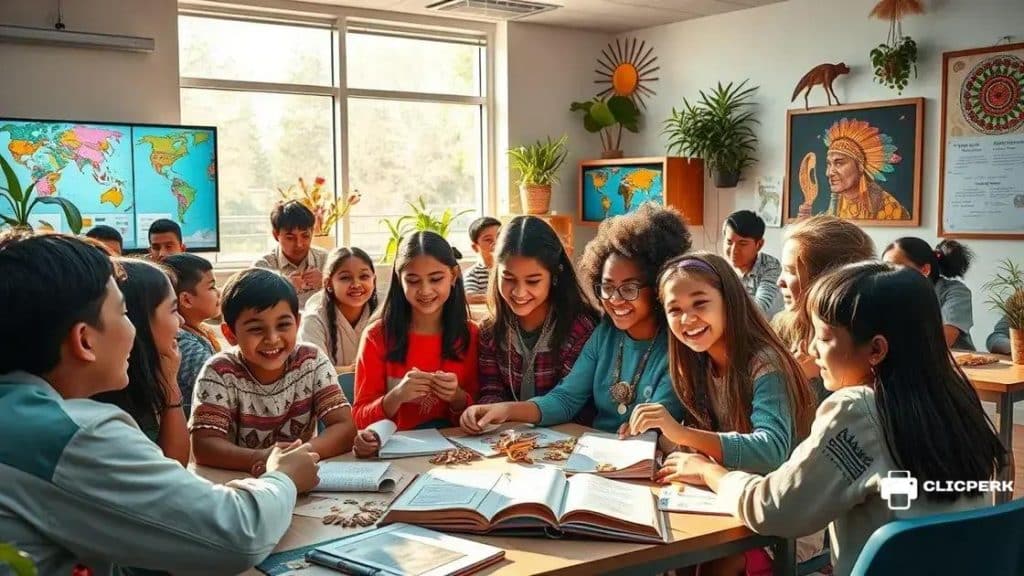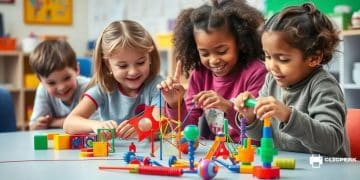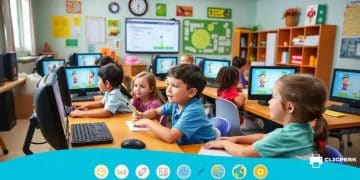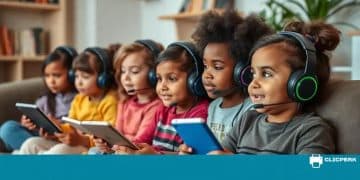Integrating Indigenous knowledge into modern curricula

Anúncios
Integrating Indigenous knowledge into modern curricula enriches the educational experience by enhancing cultural awareness, promoting critical thinking, and fostering community involvement among students.
Integrating Indigenous knowledge into modern curricula has the potential to enrich the educational landscape. Have you ever wondered how traditional wisdom can enhance contemporary learning? Let’s explore this intriguing intersection.
Anúncios
The importance of Indigenous knowledge
Understanding the importance of Indigenous knowledge is essential in today’s educational landscape. This knowledge offers unique perspectives that enrich our learning experiences. By integrating these viewpoints, students can gain a deeper appreciation for diverse cultures.
Valuable insights from Indigenous practices
Indigenous knowledge encompasses not just cultural teachings but also sustainable practices that have been honed over centuries. For instance, traditional practices of agriculture, hunting, and land stewardship highlight methods that promote ecological balance. This knowledge can significantly inform contemporary environmental issues.
Benefits of embracing Indigenous knowledge
Incorporating this wisdom into curricula offers several advantages:
Anúncios
- Enhanced cultural awareness among students
- Promotion of critical thinking and problem-solving skills
- Fostering a sense of respect and responsibility towards the environment
Furthermore, Indigenous knowledge can bridge gaps between cultures, encouraging dialogue and collaboration among students from diverse backgrounds.
Challenges in recognition and integration
Despite its significance, the integration of Indigenous knowledge faces challenges. Many educational systems prioritize Western methodologies, often overlooking these valuable insights. It’s crucial to acknowledge these obstacles while actively seeking ways to overcome them.
By recognizing the importance of Indigenous knowledge, educators can create a richer and more inclusive learning environment that prepares students for a globalized world. Understanding and respecting this knowledge is a step towards a more equitable education for all.
Practical approaches to integration
Exploring practical approaches to integration of Indigenous knowledge in modern curricula opens doors to innovative teaching methods. Educators are discovering that weaving these perspectives into existing frameworks can enhance learning for all students.
Collaborative curriculum design
One effective way to integrate Indigenous knowledge is through collaborative curriculum design. This involves working closely with Indigenous communities to ensure accurate representation of their culture and traditions. Such partnerships can lead to:
- Authentic learning experiences
- Culturally relevant materials
- Strengthened community ties
Educators should actively seek out these collaborations, as they facilitate a more meaningful connection between students and the content.
Incorporating storytelling methods
Storytelling is a key aspect of many Indigenous cultures. By integrating storytelling into lesson plans, teachers can provide students with rich narratives that convey important cultural lessons. This approach not only makes learning more engaging but also fosters empathy and understanding among students.
Additionally, utilizing storytelling helps students develop critical thinking skills as they analyze narratives and themes. It encourages them to make connections between their lives and the teachings of Indigenous cultures.
Utilizing outdoor learning environments
Outdoor education provides another practical method for integrating Indigenous knowledge. Engaging students in nature allows them to learn about sustainable practices, traditional ecological knowledge, and the significance of natural resources to Indigenous peoples. Educators can design activities focused on:
- Plant identification and uses
- Local wildlife and conservation
- Connection to land and history
Such hands-on experiences are powerful, as they connect students directly with the environment and deepen their appreciation for Indigenous perspectives.
To truly embrace the practical approaches to integration, educators must remain open-minded and willing to adapt their teaching styles. This commitment will lead to a richer educational experience that honors the contributions of Indigenous cultures.
Benefits for students and educators

Understanding the benefits for students and educators when integrating Indigenous knowledge into curricula can reshape the educational experience. By embracing these diverse perspectives, schools also create enriched learning environments.
Enhanced cultural awareness
One of the significant benefits is the enhanced cultural awareness among students. Learning about Indigenous cultures and practices fosters respect and appreciation for the diversity of human experiences. This exposure helps students understand different worldviews and their historical contexts.
Improved critical thinking skills
When educators incorporate Indigenous knowledge, they often use methods that encourage critical thinking. Students engage with real-world issues, analyze various viewpoints, and evaluate the relevance of different knowledge systems. This approach not only enhances their cognitive skills but also prepares them for complex societal challenges.
- Engagement in discussions about sustainability
- Exploration of historical injustices
- Challenge assumptions and biases
Such activities promote a deeper understanding of relationships between people and the environment, equipping students with the skills needed for thoughtful action.
Strengthened educator-student relationships
Integrating Indigenous knowledge can also strengthen relationships between educators and students. When teachers show openness and respect for students’ cultural backgrounds, they create a welcoming atmosphere. This inclusivity encourages students to share their perspectives, making learning more collaborative and meaningful.
Furthermore, when educators learn about Indigenous teachings, they themselves grow, becoming more knowledgeable and empathetic. This professional development not only benefits educators but also greatly impacts the students they teach.
The benefits for students and educators are profound and wide-reaching. By valuing Indigenous knowledge, educational institutions can shape more informed, compassionate, and capable individuals ready to navigate an interconnected world.
Challenges in curriculum development
Addressing the challenges in curriculum development when integrating Indigenous knowledge is vital for effective educational practices. Many educators face obstacles that can hinder the successful inclusion of these perspectives. Understanding these challenges can help educators strategize solutions.
Resistance to change
One of the most significant barriers is resistance to change within educational institutions. Many schools have established curricula that prioritize traditional Western knowledge. This makes it difficult to implement new approaches that include Indigenous teachings. Some educators might feel unsure about how to incorporate these teachings effectively.
Lack of resources and training
Another challenge is the lack of resources and training for educators. Many teachers do not receive adequate professional development on how to teach Indigenous knowledge. Without proper training, they may feel unprepared to address this topic sensitively and accurately. This gap can lead to misinterpretation and misrepresentation of Indigenous cultures.
- Limited access to Indigenous scholars and resources
- Inadequate support for curriculum changes
- Difficulty in evaluating resources for credibility
Additionally, there is often a limited availability of culturally relevant teaching materials. Schools may struggle to find appropriate textbooks or resources that accurately reflect Indigenous perspectives.
Community involvement
Engaging with Indigenous communities can also pose challenges. Institutions may find it difficult to establish meaningful partnerships with local Indigenous groups. Building trust and effective communication between educators and community members is crucial but can take time and effort.
Educational institutions must navigate these complexities to successfully integrate Indigenous knowledge. By acknowledging and addressing the challenges in curriculum development, schools can create a more inclusive educational environment that honors the rich contributions of Indigenous cultures. This effort will ultimately benefit both students and communities.
Case studies of successful implementation
Examining case studies of successful implementation reveals how incorporating Indigenous knowledge can lead to transformative educational experiences. These real-world examples demonstrate effective strategies that schools have adopted, showing the impact on both students and the broader community.
Example: A collaborative curriculum in action
One notable case involved a school district that partnered with local Indigenous tribes to develop a collaborative curriculum. This program included storytelling, traditional ecological knowledge, and hands-on learning experiences. Students engaged in projects related to local flora and fauna, learning from Indigenous community members about sustainable practices.
Impact on student engagement
As a result of this approach, teachers reported a significant increase in student engagement and motivation. When students connected their learning to their own community, they felt a stronger sense of belonging. This method helped bridge cultural gaps, fostering respect and understanding among students from diverse backgrounds.
Community-based projects
Another successful case study highlights a high school that integrated Indigenous knowledge through service-learning projects. Students worked alongside Indigenous leaders on environmental conservation efforts. This hands-on experience allowed them to apply classroom knowledge while connecting with their local environment.
- Students learned about the importance of biodiversity
- Understanding traditional land stewardship practices
- Building relationships with Indigenous community members
Such projects not only enhanced students’ educational experiences but also strengthened community ties. They gained valuable skills and insights that will benefit them in their future endeavors.
By exploring these case studies of successful implementation, educators can recognize the immense potential of integrating Indigenous knowledge into curricula. These examples serve as powerful inspiration for other schools looking to create meaningful, inclusive learning environments.
FAQ – Questions about Integrating Indigenous Knowledge into Modern Curricula
What are the main benefits of integrating Indigenous knowledge into curricula?
Integrating Indigenous knowledge enhances cultural awareness, promotes critical thinking, and encourages community involvement among students.
What challenges do educators face when incorporating Indigenous knowledge?
Some challenges include resistance to change within institutions, lack of training and resources, and difficulties in engaging with Indigenous communities.
Can you provide examples of successful implementation?
Yes! Successful case studies include collaborative curricula that involve Indigenous community members and hands-on projects focusing on environmental conservation.
How does this integration affect student engagement?
Integrating Indigenous knowledge helps increase student engagement by connecting lessons to their community and fostering a sense of belonging.





